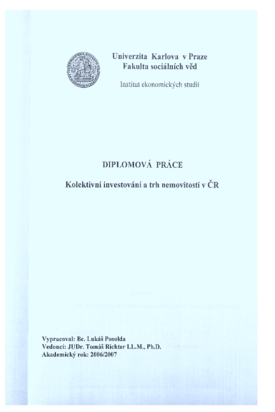Kolektivní investování a trh nemovitostí v ČR
Collective investment and real-estate market in the Czech republic
diplomová práce (OBHÁJENO)

Zobrazit/
Trvalý odkaz
http://hdl.handle.net/20.500.11956/11366Identifikátory
SIS: 2818
Kolekce
- Kvalifikační práce [18431]
Autor
Vedoucí práce
Oponent práce
Hlaváček, Michal
Fakulta / součást
Fakulta sociálních věd
Obor
Ekonomie
Katedra / ústav / klinika
Institut ekonomických studií
Datum obhajoby
27. 6. 2007
Nakladatel
Univerzita Karlova, Fakulta sociálních vědJazyk
Čeština
Známka
Velmi dobře
Novela Zákona o kolektivním investování z května 2006 otevřela možnost vzniku nemovitostních fondů v ČR. Ty budou moci existovat ve dvou formách, jako speciální fond nemovitostí určený pro nejširší investorskou veřejnost a jako fond kvalifikovaných investorů určený pouze institucionálním a "zkušeným" investorům. Tato práce podrobně zkoumá aspekty fungování nemovitostních fondů prostřednictvím podrobné analýzy legislativy, přičemž se klade zvláštní důraz na fundamentální charakteristiky nepřímého investování do nemovitostí. Práce přináší komplexní pohled na vývoj trhu nemovitostí po roce 1990 a na tomto vývoji ukazuje, jakým třídám rizika jsou nemovitostní fondy vystaveny a jaký je potenciál jejich rozvoje. Otevřenými otázkami práce zůstává, jestli je přínosné v českém kontextu uvažovat o zavedení dalšího nemovitostního investičního instrumentu typu REIT a jaké možnosti se nemovitostním fondům nabízí ve spojení s penzijní reformou. Powered by TCPDF (www.tcpdf.org)
The novelization of the Act on Collective Investment of May 2006 enabled the creation of real estate funds in the Czech Republic. These may take two forms: (1) special real estate fund which is designated for the general investment community and (2) qualified investor fund meant only for institutional and "experienced" investors. This study uses in-depth analysis of the legislation in order to examine the aspects of the functioning of the real estate fund sector while concentrating particularly on fundamental characteristics of indirect real estate investment. The study takes a global view on the property market evolution since 1990 while examining risks faced by the real estate funds and their growth potential. The questions that yet remain to be answered are if it is appropriate to introduce REIT in the Czech legislation as another real estate investment instrument and what possibilities are open to real estate funds in the context of the anticipated pension reform. Powered by TCPDF (www.tcpdf.org)
